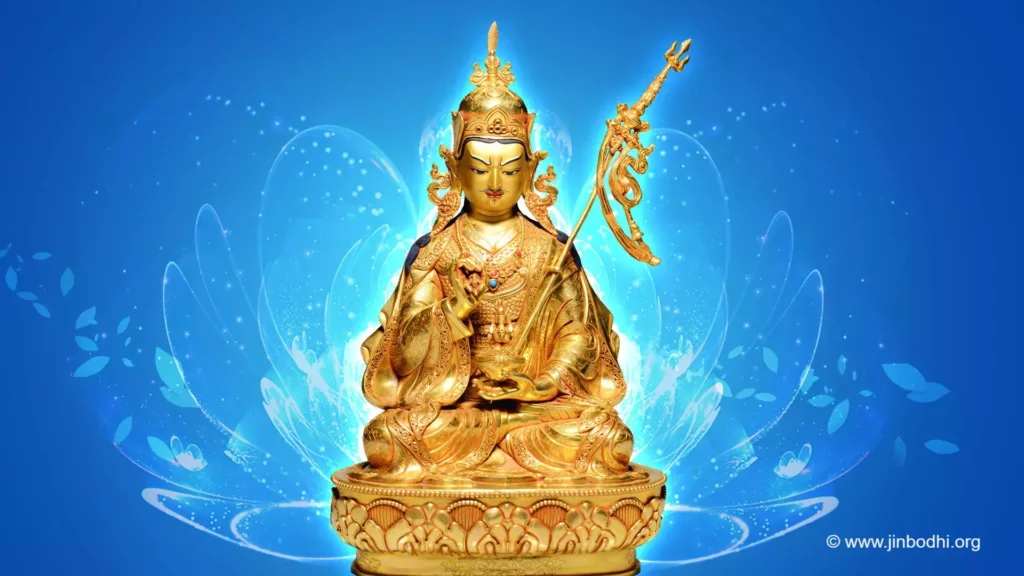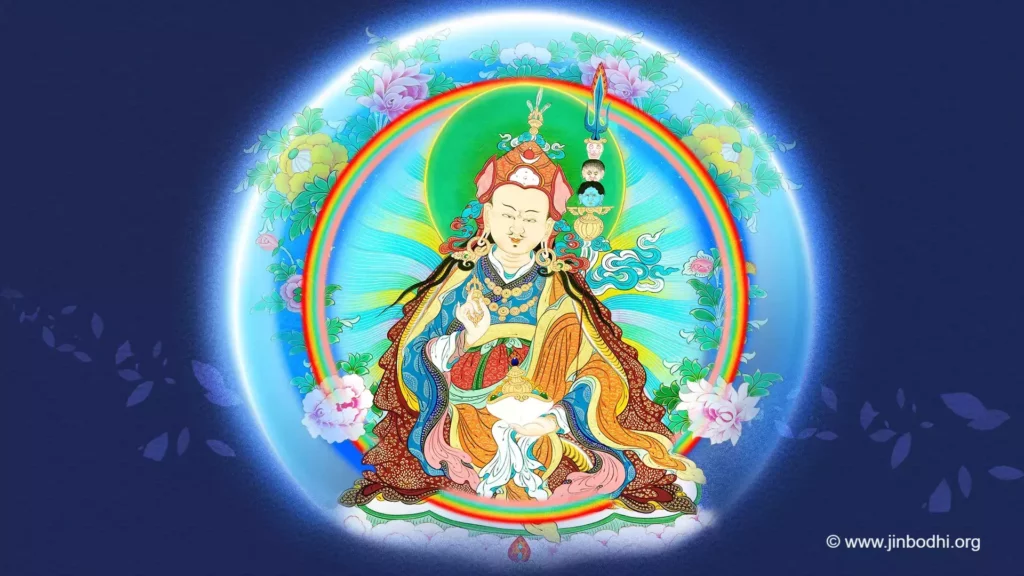
Guru Rinpoche, also known as Padmasambhava, was a significant figure who introduced Buddhism to Tibet, profoundly influencing future generations. He was also revered as the “Lotus Guru.” Read on to have all your questions about Guru Rinpoche answered.
Who Is Guru Rinpoche?
Guru Rinpoche is not only the founding patriarch of Tibetan Buddhism but also honored as the “Second Buddha” by later generations. He, along with Shantarakshita and Trisong Detsen, established a monastic community in Tibet and founded the Samye Monastery, where the three jewels (Buddha, Dharma, and Sangha) were collectively revered, earning them the title of the “Three Holy Teachers.”
The Mission of Guru Rinpoche
According to the Padma Kathang (The Chronicles of Padma), Guru Rinpoche was born eight years after the passing of Gautama Buddha, emerging miraculously from a five-colored lotus in a lake. He was then adopted by the king of Zahor who hoped Guru Rinpoche would succeed him as the ruler.
However, one day, Vajrasattva appeared and revealed Guru Rinpoche’s true mission: to renounce the throne, take monastic vows under the guidance of the venerable Ananda, and propagate the teachings entrusted to him by Gautama Buddha. Following Vajrasattva’s instructions, Guru Rinpoche renounced the throne, embarked on the path of practicing Buddhism, and studied under the guidance of Ananda and later with Master Shantarakshita at Nalanda Monastery.
Guru Rinpoche was a living buddha with powerful dharma abilities and spread his teachings in regions of India and Nepal for over 900 years. His reputation was so far-reaching that even the demons bowed to him out of fear.
The Arrival of Guru Rinpoche in Tibet
In the 8th century, the Tibetan plateau was ruled by the Tibetan Empire. While the predominant local religion was Bon, some Tibetans embraced Buddhism. One such Buddhist official, Be Snyan, visited India to learn from Shantarakshita and, upon returning, propagated Buddhism to King Trisong Detsen. Influenced by his family, Trisong Detsen was familiar with Buddhism. He ordered officials to translate Buddhist scriptures, vigorously promoted Buddhism, and even dispatched Be Snyan to invite Master Shantarakshita to visit, laying the foundation for Buddhism in Tibet. Due to obstacles encountered during the missionary efforts, Shantarakshita invited Guru Rinpoche to join and propagate Buddhism in Tibet, giving rise to the auspicious occasion of Guru Rinpoche’s arrival there.
Achievements in Propagating Buddhism
Through the efforts of Guru Rinpoche, King Trisong Detsen, and Shantarakshita, the number of Buddhist followers grew in Tibet, and Buddhism became a state religion. To promote Buddhism, Shantarakshita and Guru Rinpoche conducted a thorough examination of Tibet, leading to the establishment of the first Tibetan monastery capable of ordaining monks – Samye Monastery – and representing the complete embodiment of the three jewels. Furthermore, Guru Rinpoche founded a translation institute to train translators. Numerous Buddhist scriptures were translated into Tibetan, ensuring the comprehensive dissemination of Buddhist teachings in Tibet.
When Is Guru Rinpoche’s Birthday?
According to the Padma Kathang, Guru Rinpoche’s birthday falls on the 10th day of the 6th month in the Tibetan calendar. Due to the one-month difference between the Tibetan and Chinese lunar calendars, Guru Rinpoche’s birthday in the Chinese calendar is on the 10th day of the 7th month.

With a majestic appearance, a radiant countenance, and a gaze like the sun and the moon, Guru Rinpoche was the king of all dharmas, symbolized by the “Crown of the Dharma King” he wore. His hair and beard symbolize that a practitioner, as long as they practice diligently following the teachings, can attain supreme enlightenment whether living as a monastic or a layperson. This reminds us not to cling to external appearances, as genuine practice is to return to one’s true inner nature. Guru Rinpoche’s dharma vessels are special; the skull cup (kapala) in his left hand, made of a human skull, is the symbol of great compassion and emptiness. The long-life vase inside the cup symbolizes that only by understanding the essence of the dharma and returning to the untainted natural self, can a practitioner attain genuine eternity beyond birth and death. In the right hand, Guru Rinpoche holds the vajra pestle, symbolizing wisdom and the power to destroy all demonic ignorance and overcome all obstacles and afflictions.
Additionally, on Guru Rinpoche’s left forearm, there is a staff known as a khatvanga (three-pronged staff) with three human heads hanging from it, representing sentient beings in the three realms. The three prongs at the top signify that the wisdom of Buddha’s teachings can completely transcend all afflictions and obstacles of sentient beings in the three realms, allowing them to instantly awaken, achieve enlightenment, and attain unimpeded wisdom.
Guru Rinpoche’s Prophecy
Guru Rinpoche prophesied a brief decline of Buddhism and foresaw various societal phenomena. His prophecies encompass natural disasters and human troubles, including issues within families such as marital discord, disobedience to parents, and conflicts among siblings. Even in the 21st century, Guru Rinpoche’s prophecies continue to serve as warnings for us.
However, the prophecies are not only warnings but also serve to remind sentient beings of the karmic connection between actions and consequences. Upholding virtuous intentions and actions can help one connect with the compassionate energy of Guru Rinpoche, which brings protection and blessings, dispels calamities, and increases merit and longevity.
Guru Rinpoche’s Heart Mantra
Guru Rinpoche’s greatest wish is the wellbeing and illumination of all sentient beings, and their protection from adversity. Guru Rinpoche’s Heart Mantra contains his compassionate energy, possessing strong protective power. Listening to Grandmaster JinBodhi chanting Guru Rinpoche’s Heart Mantra brings a profound healing experience. You may also chant along with Grandmaster JinBodhi to achieve a state of mind purity.
If you wish to learn more about the stories of the well-known figures of Buddhism, feel free to subscribe to Grandmaster JinBodhi’s YouTube channel or follow his Facebook page.
Extra Reading:
What should I do if my head is lowered? Quickly determine whether your head has been dropped and learn effective ways to resolve it.